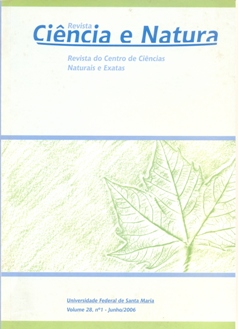Densidade de Tricomas Glandulares e Produção de Óleo Essencial em Mentha arvensis l., Mentha x Piperita l. E mentha cf. Aquatica l.
DOI:
https://doi.org/10.5902/2179460X9699Abstract
The genus Mentha has economic importance as a source ofessential oil for food, cosmetic and pharmacy industries. Terpenes arethe main constituents of the essential oil of these species and theirbiosynthesis is located in leaf peltate trichome glands. The essential oilyield and composition of the species Mentha cf. aquatica L., Mentha xpiperita L. e Mentha arvensis L. was compared and the density of trichomeglands on leaf zones (abaxial proximal, abaxial middle, abaxial distal,adaxial proximal, adaxial middle and adaxial distal) determined. Theexperiment was carried out at Center of Experimental Station of Canguiri,UFPR, using plants propagated by stem cuttings. The trichome countingwas performed by optical microscopy on expanded leaves of the sixthinternode and the essential oil extraction by hydrodistillation during sixhours. The highest density of trichomes was observed on middle andproximal zones of Mentha arvensis and distal adaxial zone of Mentha xpiperita. Mentha cf. aquatica showed the highest density of trichome ondistal zone of abaxial face. Other factors beside trichome density as lossesby volatilization and catabolism seems to be more important ondetermining the essential oil accumulation as higher yield was observedin Mentha x piperita (32.09 µL.g-1 DW) and Mentha cf. aquatica (33.23µL.g-1 DW) than in Mentha arvensis (16.61 µL.g-1 DW). The constituentslinalool and linalyl acetate were predominants on M. aquatica and M. xpiperita, and α-terpineol on M. arvensis. The obtained results indicatethe possibility to use these genetic materials for linalool production bythe cosmetic and food industry.Downloads
Downloads
Published
How to Cite
Issue
Section
License
To access the DECLARATION AND TRANSFER OF COPYRIGHT AUTHOR’S DECLARATION AND COPYRIGHT LICENSE click here.
Ethical Guidelines for Journal Publication
The Ciência e Natura journal is committed to ensuring ethics in publication and quality of articles.
Conformance to standards of ethical behavior is therefore expected of all parties involved: Authors, Editors, Reviewers, and the Publisher.
In particular,
Authors: Authors should present an objective discussion of the significance of research work as well as sufficient detail and references to permit others to replicate the experiments. Fraudulent or knowingly inaccurate statements constitute unethical behavior and are unacceptable. Review Articles should also be objective, comprehensive, and accurate accounts of the state of the art. The Authors should ensure that their work is entirely original works, and if the work and/or words of others have been used, this has been appropriately acknowledged. Plagiarism in all its forms constitutes unethical publishing behavior and is unacceptable. Submitting the same manuscript to more than one journal concurrently constitutes unethical publishing behavior and is unacceptable. Authors should not submit articles describing essentially the same research to more than one journal. The corresponding Author should ensure that there is a full consensus of all Co-authors in approving the final version of the paper and its submission for publication.
Editors: Editors should evaluate manuscripts exclusively on the basis of their academic merit. An Editor must not use unpublished information in the editor's own research without the express written consent of the Author. Editors should take reasonable responsive measures when ethical complaints have been presented concerning a submitted manuscript or published paper.
Reviewers: Any manuscripts received for review must be treated as confidential documents. Privileged information or ideas obtained through peer review must be kept confidential and not used for personal advantage. Reviewers should be conducted objectively, and observations should be formulated clearly with supporting arguments, so that Authors can use them for improving the paper. Any selected Reviewer who feels unqualified to review the research reported in a manuscript or knows that its prompt review will be impossible should notify the Editor and excuse himself from the review process. Reviewers should not consider manuscripts in which they have conflicts of interest resulting from competitive, collaborative, or other relationships or connections with any of the authors, companies, or institutions connected to the papers.






